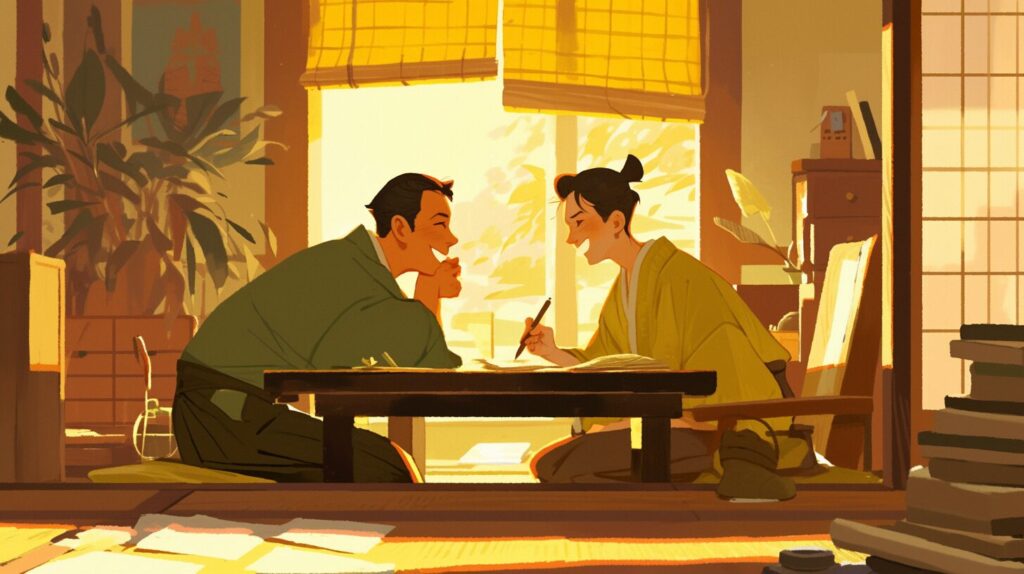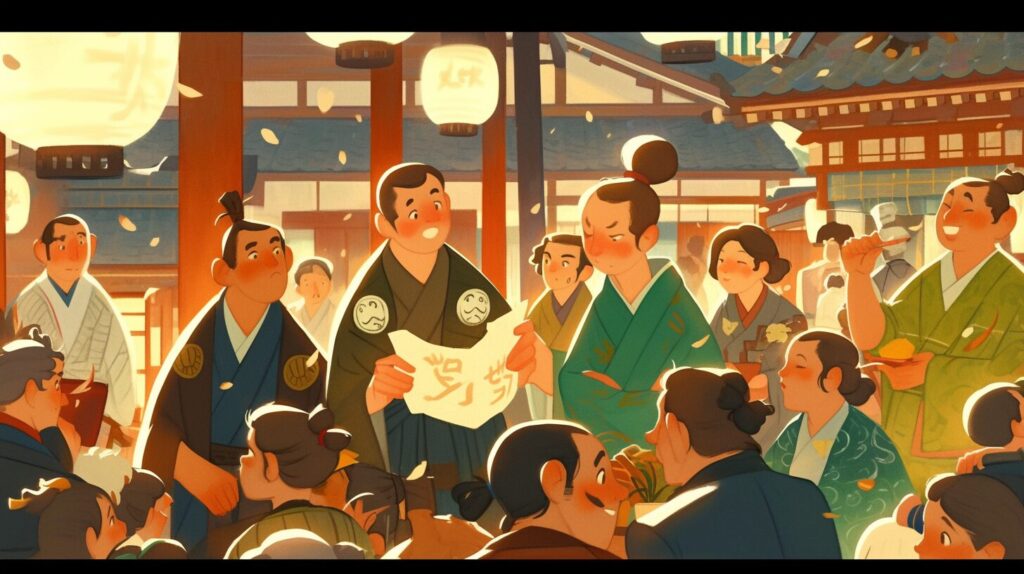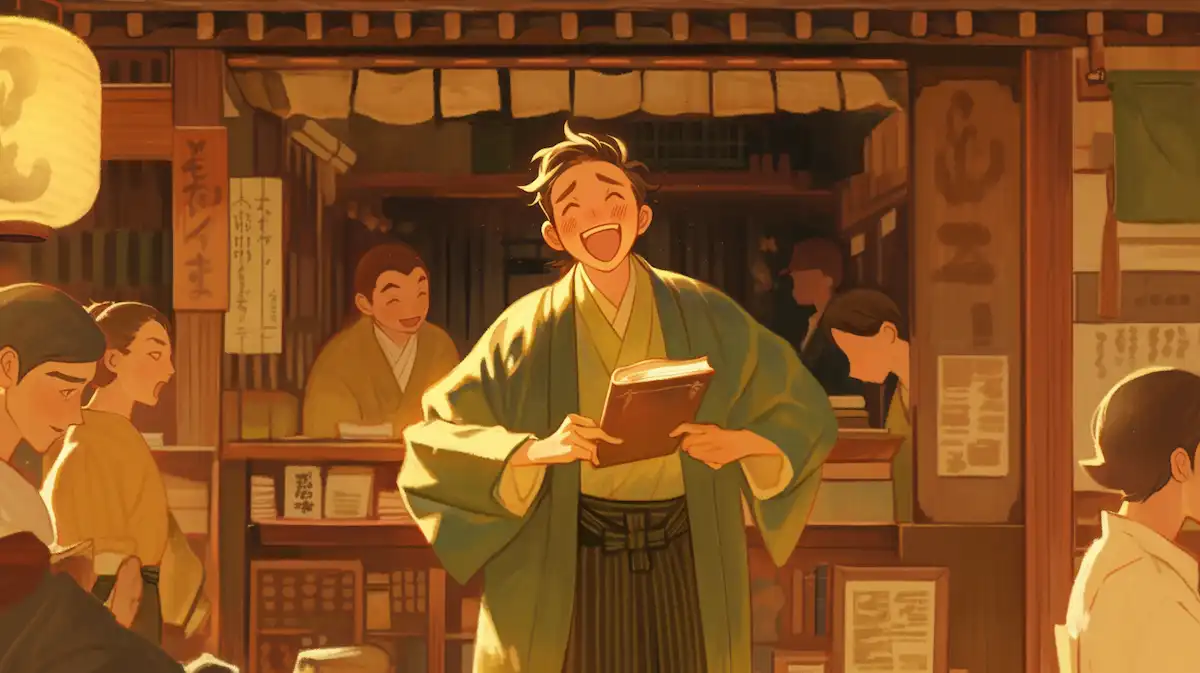蔦屋重三郎を英語で説明・紹介するための基本情報と、英会話に役立つ表現をシンプルでわかりやすい英語で紹介します。
英会話ダイアローグ・概要・10の質問を通して、蔦屋重三郎に関する英語表現を学びます。
英語
英会話ダイアローグを読む前に知っておくと良い前提知識と情報です。
- 蔦屋重三郎とは誰か?
- 江戸時代(1750-1797)に活躍した出版人・文化プロデューサー
- 浮世絵、書籍、詩集などを出版し、江戸のエンタメ文化を支えた
- 才能あるアーティストや作家を発掘・支援し、新しい文化を広めた
- 彼が発掘・支援した有名なアーティストや作家
- 喜多川歌麿:美人画の浮世絵師。蔦屋の支援で大成功
- 東洲斎写楽:役者絵(歌舞伎役者の浮世絵)を描いたが、デビューから10ヶ月で消えた謎の絵師
- 山東京伝:ユーモアや恋愛をテーマにした本を書いた作家、後に幕府に処罰された
- 平賀源内:発明家・作家、『吉原細見』の序文を執筆し、蔦屋を助けた
- 曲亭馬琴:後に『南総里見八犬伝』を書いた作家、若い頃、蔦屋に才能を見出された
- 江戸時代の出版と幕府の規制
- 当時、出版業は商業的に成功していたが、幕府の検閲が厳しかった
- 風紀を乱す内容(恋愛・風刺・遊郭関連の本)は取り締まりの対象になった
- 「寛政の改革」(1790年代)で幕府が規制を強化し、蔦屋や山東京伝も処罰された
- 『吉原細見』とは?
- 江戸の遊郭「吉原」を紹介するガイドブック
- 遊女のランキングや、どのお店が人気かなどの情報を掲載
- 現代でいう観光ガイドブックや情報誌のような役割を果たしていた、これが大ヒットし、蔦屋の名が広まった
- 寛政の改革
- 1787年から1793年頃に行われた幕府による政治改革
- 風紀の取締りが厳しくなり、出版物の検閲も強化された
- 山東京伝(作家)と蔦屋重三郎(版元)は処罰を受けた
2人が蔦屋重三郎について話しています。
蔦屋重三郎の功績、吉原細見などの出版、喜多川歌麿や東洲斎写楽などの発掘や支援、江戸の庶民文化への貢献などを話題にしています。
会話 / dialogue

Hey Key, recently I’ve been really interested in Edo period culture. There was this publisher… Tsutaya Jūzaburō, right? Do you know much about him?

Oh, yeah! He was one of the most important cultural figures in Edo. He wasn’t just a publisher—he was like a producer who shaped art and entertainment.

That sounds interesting! What made him so special?

Well, first of all, he had a great eye for talent. He discovered Kitagawa Utamaro, who became famous for beautiful women prints. Without Tsutaya’s support, Utamaro might not have become such a big name.

Oh, so he worked with artists?

Exactly. He also promoted Tōshūsai Sharaku, the mysterious ukiyo-e artist. Sharaku created powerful actor portraits, but strangely, he disappeared after just 10 months.

That’s so mysterious! But wait, was Tsutaya only involved in art?

No, he did much more. He also published popular books and guidebooks. One of his biggest hits was Yoshiwara Saiken, which was like an entertainment guide to the Yoshiwara pleasure district.

So, people in Edo used it like a tourist guide?

Pretty much! It gave information about famous courtesans and the best places to visit. It was very successful and helped him build his career.

But Edo was pretty strict, right? Wasn’t publishing risky back then?

Oh, definitely. The government didn’t like books that were too playful or romantic. That’s why Tsutaya got into trouble when he published books by Santō Kyōden, who wrote humorous and love stories.

What happened?

In 1791, during the Kansei Reforms, the government punished both Tsutaya and Kyōden. Tsutaya had to pay a huge fine, and his business suffered.

That’s tough. But did he stop publishing?

No, even after that, he kept pushing boundaries. He continued to publish ukiyo-e and poetry. Actually, he was a poet himself, using the name Tsutakaramaru.

Wow, he was so involved in culture! But he didn’t live long, right?

Right. Sadly, he died in 1797 at just 47 years old. Some say it was beriberi, a disease caused by poor nutrition.

That’s really young. But even in such a short life, he influenced so many artists and writers.

Exactly! His work helped ukiyo-e become popular worldwide. Even today, you can see Utamaro’s and Sharaku’s prints in museums around the world.

That’s amazing. The more I hear, the more I respect him. He wasn’t just a publisher—he was a visionary who shaped Edo’s entertainment world.

That’s the perfect way to put it! If he were alive today, he’d probably be a film producer or a media mogul. His influence is still strong in Japanese culture.
概要 / Overview
「蔦屋重三郎」について、理解を深めるための「英語での概要」です。
蔦屋重三郎

Who Was Tsutaya Jūzaburō?
Tsutaya Jūzaburō (1750-1797) was a famous publisher and cultural producer in Edo (now Tokyo), Japan. He published books, ukiyo-e (woodblock prints), and poetry. His work helped develop entertainment culture in Edo, and he discovered many talented artists and writers.
Supporting Famous Artists
Jūzaburō was known for finding and supporting new talent. He helped Kitagawa Utamaro, who became famous for beautiful women prints. He also promoted Tōshūsai Sharaku, a mysterious ukiyo-e artist who created powerful actor portraits but disappeared after only 10 months.
Publishing Popular Books
He did not only publish art. He also printed popular books and guidebooks. One of his most famous books was Yoshiwara Saiken, a guide to the Yoshiwara pleasure district. This book was like a tourist guide, showing the best places to visit. It became very successful and helped build his career.
Fighting Government Censorship
Publishing in Edo was dangerous because the government controlled information. In 1791, during the Kansei Reforms, Jūzaburō was punished for publishing books by Santō Kyōden, a writer of humorous and romantic stories. He had to pay a big fine, and his business suffered.
His Legacy
Jūzaburō died at 47 years old, but his influence on Japanese art and literature continues. His work helped ukiyo-e become famous worldwide, and today, his name is still remembered in Japan’s cultural history.
10の質問 / 10 questions
「蔦屋重三郎」について、理解を深めるための「英語での10の質問」です。
1: Who was Tsutaya Jūzaburō?
Tsutaya Jūzaburō was a famous publisher and cultural producer in Edo (now Tokyo), Japan. He published books, ukiyo-e (woodblock prints), and poetry, helping to shape Edo’s entertainment culture.
2: What was Tsutaya Jūzaburō’s main role in Edo society?
He was not just a publisher but also a cultural producer. He discovered and supported many artists and writers, helping them gain popularity through his publications.
3: Which famous artists did Tsutaya Jūzaburō support?
He supported Kitagawa Utamaro, known for his beautiful women prints, and Tōshūsai Sharaku, who created powerful actor portraits. He also published books by the writer Santō Kyōden.
4: What was Yoshiwara Saiken?
Yoshiwara Saiken was a popular guidebook published by Tsutaya Jūzaburō. It provided information about the Yoshiwara pleasure district, including courtesans and entertainment spots.
5: Why was publishing risky in Edo?
The Edo government controlled publications and banned books that were too playful, romantic, or critical of the authorities. Publishers could be punished if they broke these rules.
6: How was Tsutaya Jūzaburō punished by the government?
In 1791, during the Kansei Reforms, he was fined for publishing books by Santō Kyōden that contained humorous and romantic themes. His business suffered as a result.
7: What made Tsutaya Jūzaburō different from other publishers?
He had a great eye for talent and promoted both literature and visual arts. He was a pioneer in making ukiyo-e popular among the common people.
8: What kind of books did Tsutaya Jūzaburō publish?
He published ukiyo-e prints, novels, poetry, and guidebooks. His works were entertaining and visually appealing, attracting a large audience.
9: How did Tsutaya Jūzaburō influence modern Japanese culture?
His contributions helped ukiyo-e become famous worldwide. Many of the artists he supported are still celebrated today, and his impact on publishing remains strong.
10: When and how did Tsutaya Jūzaburō die?
He died in 1797 at the age of 47. Some say he suffered from beriberi, a disease caused by poor nutrition. Despite his short life, his influence on Japanese culture was significant.

和訳付
会話 / dialogue

Hey Key, recently I’ve been really interested in Edo period culture. There was this publisher… Tsutaya Jūzaburō, right? Do you know much about him?
なあキー、最近江戸時代の文化にすごく興味があるんだ。出版業をしていた…蔦屋重三郎って人、知ってる?

Oh, yeah! He was one of the most important cultural figures in Edo. He wasn’t just a publisher—he was like a producer who shaped art and entertainment.
もちろん!彼は江戸で最も重要な文化人の一人だったよ。ただの出版社の経営者じゃなくて、アートやエンタメを作り上げたプロデューサーみたいな存在だったんだ。

That sounds interesting! What made him so special?
それは面白そうだね!何がそんなに特別だったの?

Well, first of all, he had a great eye for talent. He discovered Kitagawa Utamaro, who became famous for beautiful women prints. Without Tsutaya’s support, Utamaro might not have become such a big name.
まず、彼は才能を見抜く力がすごかったんだ。例えば、喜多川歌麿を見出したんだけど、彼は美人画で有名になったよね。もし蔦屋が支えてなかったら、歌麿はそこまで有名にならなかったかもしれないんだ。

Oh, so he worked with artists?
へえ、じゃあ彼はアーティストと一緒に仕事をしていたんだね?

Exactly. He also promoted Tōshūsai Sharaku, the mysterious ukiyo-e artist. Sharaku created powerful actor portraits, but strangely, he disappeared after just 10 months.
そうだよ。それに、東洲斎写楽も世に出したんだ。写楽は力強い役者絵を描いたけど、不思議なことに、デビューしてたった10ヶ月で姿を消しちゃったんだよ。

That’s so mysterious! But wait, was Tsutaya only involved in art?
それはミステリアスだな!でもちょっと待って、蔦屋はアート関係だけだったの?

No, he did much more. He also published popular books and guidebooks. One of his biggest hits was Yoshiwara Saiken, which was like an entertainment guide to the Yoshiwara pleasure district.
いや、それだけじゃないよ。彼は人気の本やガイドブックも出版してたんだ。特に有名なのは『吉原細見』っていう本で、吉原の遊郭を紹介するエンタメガイドみたいなものだったんだ。

So, people in Edo used it like a tourist guide?
じゃあ、江戸の人たちはそれを観光ガイドみたいに使ってたんだ?

Pretty much! It gave information about famous courtesans and the best places to visit. It was very successful and helped him build his career.
まあ、そんな感じだね!有名な遊女の情報や、どこに行けばいいかが書かれてたんだ。この本が大ヒットして、彼の出版業の基盤を作ったんだよ。

But Edo was pretty strict, right? Wasn’t publishing risky back then?
でも江戸時代って結構厳しかったよね?出版って当時は危険じゃなかったの?

Oh, definitely. The government didn’t like books that were too playful or romantic. That’s why Tsutaya got into trouble when he published books by Santō Kyōden, who wrote humorous and love stories.
その通り。政府は、ふざけた内容や恋愛ものの本を嫌がってたんだ。だから、蔦屋が山東京伝のユーモアや恋愛小説を出版したとき、問題になったんだよ。

What happened?
それで、どうなったの?

In 1791, during the Kansei Reforms, the government punished both Tsutaya and Kyōden. Tsutaya had to pay a huge fine, and his business suffered.
1791年、寛政の改革の時に、政府が蔦屋と京伝を処罰したんだ。蔦屋は高額な罰金を払わされて、彼のビジネスもかなりダメージを受けたんだよ。

That’s tough. But did he stop publishing?
それはきついな。でも、出版をやめちゃったの?

No, even after that, he kept pushing boundaries. He continued to publish ukiyo-e and poetry. Actually, he was a poet himself, using the name Tsutakaramaru.
いや、それでも彼は挑戦し続けたよ。浮世絵や詩集の出版を続けたし、実は彼自身も「蔦唐丸」って名前で詩を書いてたんだ。

Wow, he was so involved in culture! But he didn’t live long, right?
すごいな、彼ってめちゃくちゃ文化に関わってたんだね!でも、長生きはしなかったんでしょ?

Right. Sadly, he died in 1797 at just 47 years old. Some say it was beriberi, a disease caused by poor nutrition.
その通り。残念だけど、1797年に47歳で亡くなったんだ。脚気(かっけ)っていう栄養不足が原因の病気だったと言われてるよ。

That’s really young. But even in such a short life, he influenced so many artists and writers.
それは若すぎるな。でも、そんな短い人生なのに、たくさんのアーティストや作家に影響を与えたんだね。

Exactly! His work helped ukiyo-e become popular worldwide. Even today, you can see Utamaro’s and Sharaku’s prints in museums around the world.
まさにそう!彼のおかげで浮世絵が世界的に有名になったんだ。今でも、歌麿や写楽の作品は世界中の美術館で展示されてるよ。

That’s amazing. The more I hear, the more I respect him. He wasn’t just a publisher—he was a visionary who shaped Edo’s entertainment world.
それはすごいな。話を聞けば聞くほど、彼を尊敬するよ。単なる出版業者じゃなくて、江戸のエンタメ界を作り上げた先見の明のある人だったんだな。

That’s the perfect way to put it! If he were alive today, he’d probably be a film producer or a media mogul. His influence is still strong in Japanese culture.
まさにその通り!もし彼が現代にいたら、映画プロデューサーかメディア業界の大物になってたかもね。彼の影響は今でも日本文化の中に息づいてるよ。
概要 / Overview
蔦屋重三郎

Who Was Tsutaya Jūzaburō?
Tsutaya Jūzaburō (1750-1797) was a famous publisher and cultural producer in Edo (now Tokyo), Japan. He published books, ukiyo-e (woodblock prints), and poetry. His work helped develop entertainment culture in Edo, and he discovered many talented artists and writers.
蔦屋重三郎とは誰か?
蔦屋重三郎(1750-1797)は、江戸(現在の東京)で活躍した有名な出版人であり文化プロデューサーでした。彼は本、浮世絵(木版画)、詩集を出版しました。彼の仕事は江戸のエンターテイメント文化の発展に貢献し、多くの才能あるアーティストや作家を発掘しました。
Supporting Famous Artists
Jūzaburō was known for finding and supporting new talent. He helped Kitagawa Utamaro, who became famous for beautiful women prints. He also promoted Tōshūsai Sharaku, a mysterious ukiyo-e artist who created powerful actor portraits but disappeared after only 10 months.
有名なアーティストの支援
重三郎は、才能を見つけ、支援する力で知られていました。彼は喜多川歌麿を支え、彼の美人画を広めました。また、東洲斎写楽という浮世絵師も世に出しました。写楽は迫力のある役者絵を描きましたが、わずか10か月後に突然姿を消しました。
Publishing Popular Books
He did not only publish art. He also printed popular books and guidebooks. One of his most famous books was Yoshiwara Saiken, a guide to the Yoshiwara pleasure district. This book was like a tourist guide, showing the best places to visit. It became very successful and helped build his career.
人気の本を出版
彼はアートだけでなく、人気のある本やガイドブックも出版しました。特に有名なのは『吉原細見』で、これは吉原の遊郭を紹介するガイドブックでした。この本は観光ガイドのようなもので、どこに行けばよいかが分かる内容でした。大ヒットし、彼の出版業を成功へと導きました。
Fighting Government Censorship
Publishing in Edo was dangerous because the government controlled information. In 1791, during the Kansei Reforms, Jūzaburō was punished for publishing books by Santō Kyōden, a writer of humorous and romantic stories. He had to pay a big fine, and his business suffered.
政府の検閲と戦う
江戸時代の出版は危険な仕事でした。なぜなら、幕府が情報を厳しく管理していたからです。1791年の寛政の改革の際、重三郎は山東京伝の本を出版したことで処罰されました。京伝の本にはユーモアや恋愛の要素があり、幕府にとって問題視されたのです。重三郎は高額な罰金を科され、彼のビジネスは大きなダメージを受けました。
His Legacy
Jūzaburō died at 47 years old, but his influence on Japanese art and literature continues. His work helped ukiyo-e become famous worldwide, and today, his name is still remembered in Japan’s cultural history.
彼の遺産
重三郎は47歳という若さで亡くなりましたが、彼の影響は日本の芸術や文学に今も残っています。彼の仕事のおかげで、浮世絵は世界的に有名になりました。そして現在でも、日本の文化史にその名が刻まれています。
10の質問 / 10 questions
1: Who was Tsutaya Jūzaburō?
蔦屋重三郎とは誰ですか?
Tsutaya Jūzaburō was a famous publisher and cultural producer in Edo (now Tokyo), Japan. He published books, ukiyo-e (woodblock prints), and poetry, helping to shape Edo’s entertainment culture.
蔦屋重三郎は、江戸(現在の東京)で活躍した有名な出版人であり文化プロデューサーでした。彼は本、浮世絵(木版画)、詩を出版し、江戸のエンターテイメント文化の発展に貢献しました。
2: What was Tsutaya Jūzaburō’s main role in Edo society?
蔦屋重三郎の江戸社会での主な役割は何でしたか?
He was not just a publisher but also a cultural producer. He discovered and supported many artists and writers, helping them gain popularity through his publications.
彼は単なる出版人ではなく、文化プロデューサーでもありました。多くの芸術家や作家を発掘・支援し、出版を通じて彼らを有名にしました。
3: Which famous artists did Tsutaya Jūzaburō support?
蔦屋重三郎はどの有名な芸術家を支援しましたか?
He supported Kitagawa Utamaro, known for his beautiful women prints, and Tōshūsai Sharaku, who created powerful actor portraits. He also published books by the writer Santō Kyōden.
彼は美人画で知られる喜多川歌麿や、力強い役者絵を描いた東洲斎写楽を支援しました。また、作家の山東京伝の書籍も出版しました。
4: What was Yoshiwara Saiken?
『吉原細見』とは何ですか?
Yoshiwara Saiken was a popular guidebook published by Tsutaya Jūzaburō. It provided information about the Yoshiwara pleasure district, including courtesans and entertainment spots.
『吉原細見』は蔦屋重三郎が出版した人気のガイドブックでした。遊女や遊郭の情報を提供し、吉原の遊興スポットを紹介しました。
5: Why was publishing risky in Edo?
江戸時代において、出版が危険だったのはなぜですか?
The Edo government controlled publications and banned books that were too playful, romantic, or critical of the authorities. Publishers could be punished if they broke these rules.
江戸幕府は出版を厳しく管理し、娯楽性が強いものや恋愛をテーマにしたもの、または幕府を批判する内容の本を禁止しました。これらのルールを破ると、出版人は処罰される可能性がありました。
6: How was Tsutaya Jūzaburō punished by the government?
蔦屋重三郎は政府からどのように処罰されましたか?
In 1791, during the Kansei Reforms, he was fined for publishing books by Santō Kyōden that contained humorous and romantic themes. His business suffered as a result.
1791年、寛政の改革の際に、山東京伝のユーモアや恋愛をテーマにした本を出版したことで罰金を科されました。その結果、彼のビジネスは大きな打撃を受けました。
7: What made Tsutaya Jūzaburō different from other publishers?
蔦屋重三郎が他の出版人と違っていた点は何ですか?
He had a great eye for talent and promoted both literature and visual arts. He was a pioneer in making ukiyo-e popular among the common people.
彼は優れた才能を見抜く力を持ち、文学と美術の両方を支援しました。庶民の間で浮世絵を普及させた先駆者でもありました。
8: What kind of books did Tsutaya Jūzaburō publish?
蔦屋重三郎はどのような本を出版しましたか?
He published ukiyo-e prints, novels, poetry, and guidebooks. His works were entertaining and visually appealing, attracting a large audience.
彼は浮世絵、物語本、詩集、ガイドブックを出版しました。彼の作品は娯楽性が高く、視覚的にも魅力的だったため、多くの人々に人気がありました。
9: How did Tsutaya Jūzaburō influence modern Japanese culture?
蔦屋重三郎は現代の日本文化にどのような影響を与えましたか?
His contributions helped ukiyo-e become famous worldwide. Many of the artists he supported are still celebrated today, and his impact on publishing remains strong.
彼の貢献により、浮世絵は世界的に有名になりました。彼が支援した芸術家の多くは今でも称賛されており、出版業界への影響も現在まで続いています。
10: When and how did Tsutaya Jūzaburō die?
蔦屋重三郎はいつ、どのように亡くなりましたか?
He died in 1797 at the age of 47. Some say he suffered from beriberi, a disease caused by poor nutrition. Despite his short life, his influence on Japanese culture was significant.
彼は1797年に47歳で亡くなりました。栄養不足が原因の病気である脚気(かっけ)だったと言われています。短い生涯でしたが、日本文化への影響は非常に大きなものでした。

words & phrases
英会話ダイアローグと関連情報に出てきた単語・フレーズです(例文は各3つ)。

promote : 動詞
意味: 促進する、昇進させる、宣伝する。To support, encourage, or advance something.
(蔦屋重三郎がアーティストや作家を世に広める際に使用)
例文:
- Tsutaya Jūzaburō worked hard to promote ukiyo-e art.
「蔦屋重三郎は浮世絵の普及に尽力した。」 - The company is trying to promote its new product.
「その会社は新製品を宣伝しようとしている。」 - He was promoted to manager last year.
「彼は昨年、マネージャーに昇進した。」
courtesan : 名詞
意味: (特に歴史的に)高級遊女。A high-class prostitute, often associated with nobility or influential figures.
(『吉原細見』の中で紹介される吉原遊郭の遊女を指す)
例文:
- Yoshiwara Saiken provided details about famous courtesans in Edo.
「『吉原細見』は江戸の有名な遊女の詳細を提供していた。」 - In the past, some courtesans had great influence in politics.
「昔、一部の遊女は政治に大きな影響を持っていた。」 - The novel tells the story of a beautiful courtesan in Kyoto.
「その小説は、京都の美しい遊女の物語を描いている。」
playful : 形容詞
意味: 遊び心のある、ふざけた。Full of fun, lighthearted, or joking.
(江戸時代の出版規制において、政府が「ふざけすぎた」本を問題視した)
例文:
- The government banned books that were too playful.
「政府は遊び心が強すぎる本を禁止した。」 - The children were in a playful mood.
「子供たちは遊び心いっぱいの様子だった。」 - He gave her a playful smile.
「彼は彼女にいたずらっぽい笑みを浮かべた。」
visionary : 形容詞
意味: 先見の明がある、未来を見据えた。Having strong foresight, imagination, or the ability to plan for the future.
(蔦屋重三郎がアートや出版を通じて江戸のエンタメを変えたことを表す)
例文:
- Tsutaya Jūzaburō was a visionary in Edo culture.
「蔦屋重三郎は江戸文化における先見の明のある人物だった。」 - She is a visionary leader with great ideas for the future.
「彼女は未来のための素晴らしいアイデアを持つ先見の明のあるリーダーだ。」 - The scientist’s visionary ideas changed modern technology.
「その科学者の先見的なアイデアは現代技術を変えた。」
mogul : 名詞
意味: (特にビジネスやメディア業界の)大物、有力者。A powerful and influential person, especially in business or media.
(蔦屋重三郎が現代にいたら「メディア界の大物」になっていただろう、という文脈で使用)
例文:
- If he lived today, Tsutaya Jūzaburō would be a media mogul.
「もし彼が現代にいたら、メディア業界の大物になっていただろう。」 - The tech mogul invested in several start-up companies.
「そのテクノロジー業界の大物は、いくつものスタートアップ企業に投資した。」 - The film mogul produced many Hollywood blockbusters.
「その映画業界の大物は、数々のハリウッドの大ヒット作を生み出した。」
